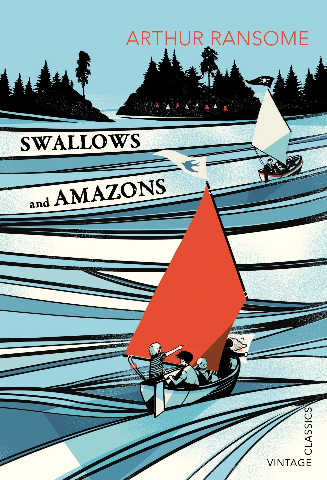I have written a book review for ‘Swallows and Amazons’ before, but I have learned a lot more since then and started doing themes. Plus, my favourite character has changed! Click here to see the original.
The first of a twelve-book series, Swallows and Amazons is an illustrated, classic adventure by Arthur Ransome. In the modern day, Swallows and Amazons is a bit old-fashioned but takes place in the author’s present. Setting sail in Swallow, Captain John Walker, Mate Susan Walker, Able-seaman Titty Walker and Ship’s Boy Roger Walker travel to Wild-Cat Island for the summer holidays. They have a peaceful life on the island, collecting milk and other supplies from the natives, the Dixons, and being visited by other natives, their mother and little sister. However, they soon meet the Amazon pirates, Captain Nancy and Mate Peggy, and the angry, book-writing retired pirate called Captain Flint. Now, two storms are rolling in: one of war and one of wind and thunder!
The Swallows, Amazons and Captain Flint appear in other books including Swallowdale and Peter Duck. Susan is very responsible and sometimes more native than explorer. Meanwhile, Roger can be really funny: when Susan tells him to put on two of everything, he says ‘I can’t put on two pairs of shoes’. Titty is extremely clever, as she captures the Amazon in the war between the Amazons and Swallows. John, Susan and Roger go to capture the Amazon and leave Titty in charge of lighting the lanterns at the harbour when she hears their owl call. Mistaking a real owl for the other Swallows, Titty accidentally lights the harbour lanterns for the Amazons! However, the pirates leave their ship in the harbour, allowing Titty to capture it. This is why Titty is my favourite character.
One of the main themes is sailing and boats: the children pretend that the lake is an ocean. Also Captain Flint lives in a houseboat and the Swallows’ father is a sailor. The houseboat is where the main war takes place and Captain Flint walks the plank. The book tells the reader that the Swallows’ father taught John and Susan how to sail. In order to sail, the children must be responsible and independent, another theme. Susan is the most responsible and Roger is probably the least independent. Susan, sometimes helped by Peggy, is in charge of cooking and preparing food. She is also in charge of the fire and is regularly repairing Roger’s buttons. As the youngest Swallow, Roger needs help from John to learn how to swim. When he bruises his leg on Cormorant Island, Titty uses a handkerchief to bandage it. One more theme is role-playing. Even though the children are cooking their own food, making fires and sailing, their adventures seem to be a game: they pretend that the lake is an ocean, that the locals and their mother are natives and that the Amazons come from the Amazon River. When Titty is alone on the island and visited by Mother, she pretends that she is the stranded sailor Robinson Crusoe and that Mother is Man Friday.
In my first book review, I said that I wanted the book to be more funny. However, I now believe the book is best without and has the right amount of humour. This is because when I was younger, humour was the main thing that kept me interested. Now, I appreciate good lines and writing techniques like personification more than humour.
I believe that 8-year-olds and older can understand the plot and technical terms. However, I would recommend this book to 10-year-olds and older, who might be able to get more out of it.


